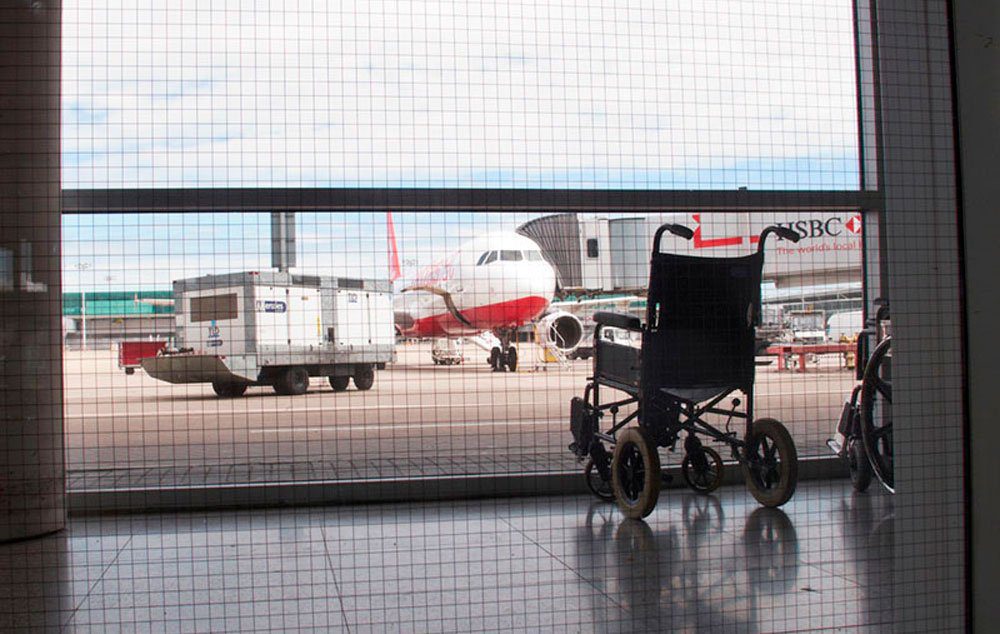Traveling for pleasure can be one of life’s most rewarding experiences. Sure, a mobility disability can often add a layer of complexity to this endeavor, but nothing insurmountable. A little planning on your part goes a long way towards making your adventure an enjoyable one.
Often the most challenging part of trip planning, is determining how to get to your chosen destination. Let’s focus on your best bets for selecting your airline flights and seats to tackle the wild blue yonder.
Direct Flights vs. Stopovers: Is shortest route the best choice for your disability?
While the shortest or most direct flights may seem like the logical choice when traveling, there are a few things to consider. If you have a mobility disability, you will want to consider how long you feel comfortable sitting in an airplane seat and the frequency of restroom breaks.
As airlines work to maximize space, both the seats and restrooms have become increasing smaller on domestic flights. In many cases the restroom cannot accommodate an onboard wheelchair or aisle chair. Keep in mind, if you have a mobility disability, you will be the one of the first passengers to board the flight and one of the last passengers to disembark. This can easily add an hour to your time languishing on the plane.
Adding a stopover to longer flights can be a good idea, but you will want to take timing into consideration. As a rule of thumb always allow at least one hour in between flights to allow for disembarking your first flight and boarding your next flight. If you need your own mobility equipment while in the airport (as opposed to an airline wheelchair), you need to request that your equipment is tagged to be delivered to you at your layover stop, otherwise it will continue on with the rest of the checked baggage directly to your next flight. A layover can often give you a nice break from the cramped plane quarters and the ability use the restroom but only as long as you factor in enough time.
How Accessible is Your Airline Seat?
Some airlines offer open seating while others will allow you to select your seat at booking. Whether you select your seat in advance or at the time of boarding, you often need to make a few choices.
The first is selecting a window, middle or aisle seat. Consider these factors: what is your ability to transfer and does your body tend to lean to a particular side? If a transferring can be difficult, consider an aisle seat so that you only need to transfer from your own wheelchair or the airline’s aisle chair once. If transferring is not a factor, think about how your body is most comfortable; do you sit straight up or do you tend to favor leaning towards a particular side. Use this information to determine which seat will give you the best support.
The next choice involves selecting a seat with more legroom or with moveable seat arms. Very often people with mobility disabilities are drawn to the “bulkhead” seats or seats at the front of the plane. These seats offer more legroom and can be a good choice. On the other hand, these seats often do not have moveable armrests due to the tray tables. If you need to be able to transfer directly from a chair to your flight seats with a slide board, you may want to select a seat with a moveable armrest to allow you to slide from the aisle chair directly into your seat. Contact your airline carrier directly to determine how the seats are configured on your flight.
Booking Your Flight: Phone Trumps Online for Disability Travel
Once you have decided on the best flight and seat for your needs, you should be ready to book. You will want to contact your airline carrier directly to determine the best course of action and for getting the seat that you need. True, in an era where airlines charge you for every little thing, you may incur a fee for booking over the phone as opposed to reserving your flight through their website. Pay it. By talking to an agent before booking, you will learn the best way to get what you need and how to avoid any additional fees. The airline can also provide you with valuable information about how to check in at the ticket counter and at your travel gate.
You are now ready to plan the rest of your trip, congratulations!
Autumn Grant has more than two decades of experience traveling across the United States using a power wheelchair. She has a passion for helping others plan accessible travel experiences.
Source: abilities.com



